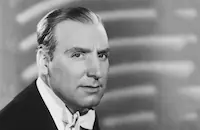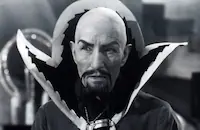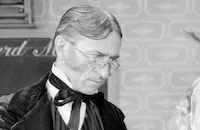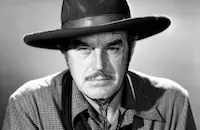Stand-In
Brief Synopsis
Cast & Crew
Tay Garnett
Leslie Howard
Joan Blondell
Humphrey Bogart
Alan Mowbray
Marla Shelton
Film Details
Technical Specs

Synopsis
Cranky old Fowler Pettypacker, head of the banking firm of Pettypacker & Sons, decides to disregard the recommendation made by his vice-president, Atterbury Dodds, that the firm should not sell Colossal Film Company, which has been losing money, to the Hollywood Cinema Finance company, headed by shyster Ivor Nassau, for half its value to get rid of it. Atterbury, considered to be the most brilliant brain developed by Wall Street in the past ten years, wants to protect the investment of the firm's 30,000 stockholders, so he offers to go to Hollywood to investigate. Pettypacker agrees, but warns Atterbury not to return if he fails. In Hollywood, Nassau, who is infamous for making money by closing and selling studios, plots with star Thelma Cheri, her fiancé, foreign director Koslofski and press agent Tom Potts to drive the studio under through expensive retakes on their current picture and to try to influence Atterbury. Arriving wide-eyed at the sights of the film capital, Atterbury fortunately meets Cheri's stand-in, Lester Plum, when she jumps into his limousine and takes off her shoes. Later, Atterbury returns a shoe she left behind in the limo, and Lester, who knows the business intimately, having once been a child star, offers herself to the naïve and shy Atterbury as his secretary. Oblivious to Lester's flirtations, Atterbury learns dance steps from her which he uses with Cheri at Koslofski's party, thus provoking Lester's jealousy and ire. After a preview screening of Cheri's latest film, Sex and Satan , producer Douglas Quintain, who made Cheri into a star and still loves her, calls the film a "turkey" and urges Atterbury to "junk it," rather than try to save it with retakes. Koslofski advises expensive retakes and blames the problems on Quintain's drunkenness. When Cheri says that Koslofski's accusations are true, Quintain quits and goes on a drinking binge, but Atterbury arranges an audience preview and learns from the reactions that Quintain was right. Attenbury then finds Quintain and using jujitsu, which he has learned from Lester, gets him into a taxi, where Quintain drinks a case of beer and sobers up by the morning. The only way to save the studio is to recut the picture, but Cheri's contract stipulates that she must approve the editing. Realizing that Cheri's contract will be considered breached if she is caught in a scandal, Atterbury takes her drinking. In the early hours of the morning, a drunken Cheri slips under the table of a club, and when Atterbury joins her, their "romance" makes headlines. Pettypacker reads the news and fires Atterbury, then agrees to sell the studio to Nassau. After Lester berates Atterbury for being unconcerned about the studio employees who will lose their jobs, Atterbury convinces the skeptical employees to work with Quintain for forty-eight hours for no pay to remake the film as a comedy, rather than lose their jobs if the film is scrapped and the deal with Nassau is consummated. Nassau is then ceremoniously thrown over the studio wall, and after Atterbury dictates to Lester a telegram informing Pettypacker of the situation, he consults his checklist of things to do, sees that he has written "Propose to Miss Plum," and asks her to marry him. She accepts and they hesitatingly kiss.

Director

Tay Garnett
Cast

Leslie Howard

Joan Blondell

Humphrey Bogart

Alan Mowbray
Marla Shelton

Jack Carson

C. Henry Gordon

Tully Marshall
J. C. Nugent

William V. Mong
Art Baker

Charles Middleton
Esther Howard

Olin Howland
Charles Williams
Pat Flaherty

Harry Myers
Anne O'neal
Theodore Von Eltz

Harry Woods
Hal Gleason
Crew
Graham Baker
Charles [g.] Clarke
Richard Foster
Charles Kerr
Otho Lovering
Paul Neal
Connie Rae
Heinz Roemheld
Rex Rommell
Wade Rubottom
Dorothy Spencer
Helen Taylor
Alexander Toluboff
Gene Towne
Walter Wanger

Photo Collections
Videos
Movie Clip



Film Details
Technical Specs

Articles
Stand-In
The film that resulted from this odd pairing of personnel and material succeeds nevertheless, proof that during the golden era of Hollywood, anything was possible. That's the lesson learned in the film by Atterbury Dodd (Leslie Howard), an efficiency expert for a New York bank who takes over Colossal Studios to prove it should not be sold. Completely absorbed in facts and figures, Dodd is baffled by the bizarre manner in which Hollywood conducts its business. His director (Alan Mowbray) will not consider shooting a scene until real edelweiss is flown in and his star (Marla Shelton) has a contract so extensive that she practically runs the studio. Dodd does get help from his star's stand-in (Joan Blondell) who points out the many workers relying on him to save the studio while she also attracts his attention to her feminine charms.
Leslie Howard, always a bit of a stuffed shirt on screen, is perfectly cast as Dodd and gets a rare chance to indulge in slapstick. Joan Blondell is, as always, both sexy and funny as the stand-in. Explaining to Dodd who Shirley Temple is, Blondell does a perfect impression of the then box-office superstar while singing "On the Good Ship Lollipop." Bogart, in a smaller role as the producer of the film within the film, is completely Bogart from the second he walks on screen, even while carrying a Scottish terrier under his arm. His speech lambasting the lead actress contains more than an echo of his final speech to Mary Astor in The Maltese Falcon (1941). It seems almost impossible that an actor with such obvious star quality had four more years of small roles before becoming a star in his own right.
According to Stand-In director Tay Garnett, he hadn't thought about casting Bogart in the film until Mayo Methot, Bogie's wife at the time, accosted him at dinner one night complaining, "Why can't the best actor in the world get to play anything but heavies? And what the hell are you going to do about it?" However, while watching rushes of the film, Garnett's friend and former assistant Paul Schwegler turned to the director and said, "Have you lost your cotton pickin' mind? What makes you think you can turn that guy into a leading man? The sonabitch LISPS!" But Garnett had faith in Bogart and later stated in his autobiography (Light Your Torches and Pull Up Your Tights!) that "Stand-In was Bogie's first sympathetic part and catapulted him straight into the arms of Ingrid Bergman, Katharine Hepburn, and Lauren Bacall (for real)."
Prior to the release of Stand-In, Joseph Breen, head of PCA (Hollywood's self-censorship committee), took issue with some of the content, particularly anything that suggested "illicit sex relations" between the characters. Annotations on the movie in the American Film Institute Catalog reveal that Walter Wanger eventually agreed to several changes, "including changing the character of "Thelma Cheri" to that of an unmarried woman; deleting a speech about the stifling of competition in the industry and the crushing of independent companies by the majors; and deleting a speech by Atterbury at the end, in which he says he is going to start a Senate investigation of the motion picture business."
At the beginning of the film, a large title card reads, "The characters and events depicted in this motion picture are fictitious. Any similarity to actual persons, living or dead, is purely coincidental." Of course, this probably means characters were based on actual Hollywood celebrities but the in-jokes are a bit obscure after 66 years. The villain, Ivor Nassau, might be David O. Selznick as he has an addiction to horse racing and a sign outside his office that suspiciously resembles the "Selznick International Pictures" logo. Could the accented director, Koslofski, be a dig at MGM's Richard Boleslawski or possibly even Erich von Stroheim or Josef von Sternberg?
Producer: Walter Wanger
Director: Tay Garnett
Screenplay: Gene Towne, C. Graham Baker, Clarence Budington Kelland (novel)
Cinematography: Charles Clarke
Film Editing: Otho Lovering, Dorothy Spencer
Art Direction: Alexander Toluboff
Music: David Klatzkin, Alfred Newman, Heinz Roemheld
Cast: Leslie Howard (Atterbury Dodd), Joan Blondell (Lester Plum), Humphrey Bogart (Doug Quintain), Alan Mowbray (Koslofski), Marla Shelton (Thelma Cheri), C. Henry Gordon (Ivor Nassau), Jack Carson (Tom Potts).
BW-91m.
by Brian Cady

Stand-In
Stand-In - STAND-IN on DVD
The film that resulted from this odd pairing of personnel and material succeeds nevertheless, proof that during the golden era of Hollywood, anything was possible. That's the lesson learned in the film by Atterbury Dodd (Leslie Howard), an efficiency expert for a New York bank who takes over Colossal Studios to prove it should not be sold. Completely absorbed in facts and figures, Dodd is baffled by the bizarre manner in which Hollywood conducts its business. His director (Alan Mowbray) will not consider shooting a scene until real edelweiss is flown in and his star (Marla Shelton) has a contract so extensive that she practically runs the studio. Dodd does get help from his star's stand-in (Joan Blondell) who points out the many workers relying on him to save the studio while she also attracts his attention to her feminine charms.
Leslie Howard, always a bit of a stuffed shirt on screen, is perfectly cast as Dodd and gets a rare chance to indulge in slapstick. Joan Blondell is, as always, both sexy and funny as the stand-in. Explaining to Dodd who Shirley Temple is, Blondell does a perfect impression of the then box-office superstar while singing "On The Good Ship Lollipop." Bogart, in a smaller role as the producer of the film within the film, is completely Bogart from the second he walks on screen, even while carrying a Scottish terrier under his arm. His speech lambasting the lead actress contains more than an echo of his final speech to Mary Astor in The Maltese Falcon (1941). It seems almost impossible that an actor with such obvious star quality had four more years of small roles before becoming a star in his own right.
At the beginning of the film, a large title card reads, "The characters and events depicted in this motion picture are fictitious. Any similarity to actual persons, living or dead, is purely coincidental." Of course, this probably means characters were based on actual Hollywood celebrities but the in-jokes are a bit obscure after 66 years. The villain, Ivor Nassau, might be David O. Selznick as he has an addiction to horse racing and a sign outside his office that suspiciously resembles the "Selznick International Pictures" logo. Could the accented director, Koslofski, be a dig at MGM's Richard Boleslawski?
Although unaccompanied by extras, this DVD presentation of Stand-In does feature a near flawless print with good sound quality. Its historical portrait of moviemaking in 1937 would make it valuable even without its undeniable comic writing and performances.
For more information about Stand-In, visit Image Entertainment, Inc.. To purchase a copy of Stand-In, visit TCM Shopping.
by Brian Cady
Stand-In - STAND-IN on DVD
Quotes
Hasn't anyone an answer for stupidity besides "that's the picture business"?- Atterbury Dodd
I'm sorry Mr. Dodd, but that's the only answer.- Studio Employee
Trivia
Notes
While screen credits list Rex Rommell as musical director, all the reviews credited Heinz Roemheld. A New York Times article noted the following: this film was perhaps the most ambitious of the many films made after the success of A Star Is Born, which portrayed Hollywood in a sentimental, as opposed to a more realistic manner; director Tay Garnett generally rehearsed two-to-three hours before a take, and usually one take sufficed; and the Leslie Howard role was similar to that of Gary Cooper in Mr. Deeds Goes to Town, which was also based on a story by Clarence Budington Kelland.
According to information in the MPAA/PCA Collection at the AMPAS Library, PCA Director Joseph Breen found the story submitted to the PCA in March 1937 "unacceptable" because of the portrayal of "Thelma Cheri" as a "loose woman" and that of other characters as being involved in "illicit sex relations." Breen also commented, "The specific and general treatment of the characters and situations, which reflect unfavorably upon the motion picture industry and its personnel, is objectionable from the point of view of general industry policy." Subsequently, suggestions by the PCA were accepted by Walter Wanger Productions, including changing the character of "Thelma Cheri" to that of an unmarried woman; deleting a speech about the stifling of competition in the industry and the crushing of independent companies by the majors; and deleting a speech by Atterbury at the end, in which he says he is going to start a Senate investigation of the motion picture business.
In Garnett's autobiography, he relates that after Bogart's wife, Mayo Methot, complained that Bogart was only getting "heavy" parts, Garnett convinced Walter Wanger to use Bogart in this role, hoping that it would lead to romantic leads for him. Garnett erroneously recollected that Gregory Ratoff was in the film and that it was based on a story by Ben Ames Williams. Modern sources note that Bogart and Joan Blondell were loaned from Warner Bros. and that Paul Schwegler was Garnett's second assistant.

Miscellaneous Notes
Released in United States 1937
Released in United States 1937













